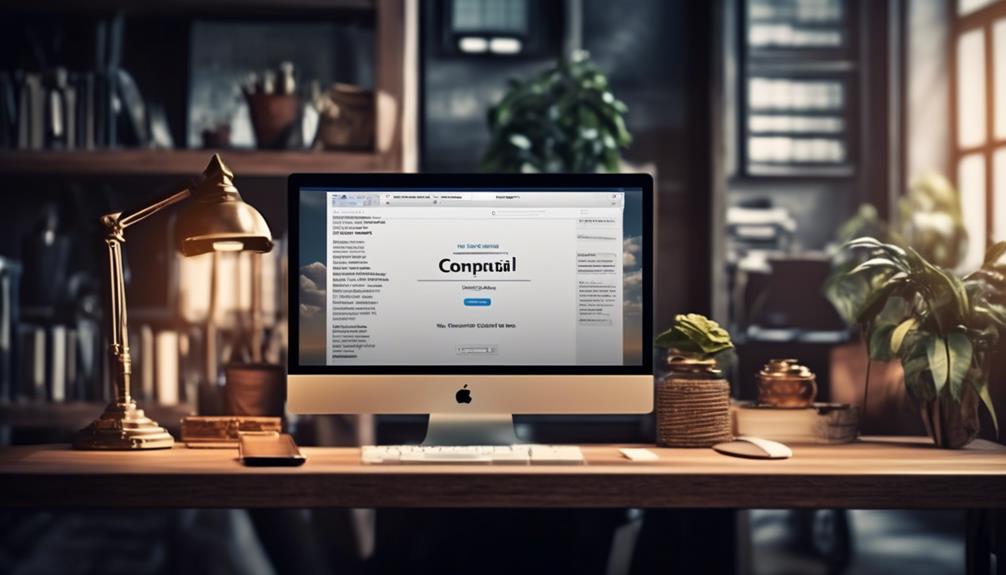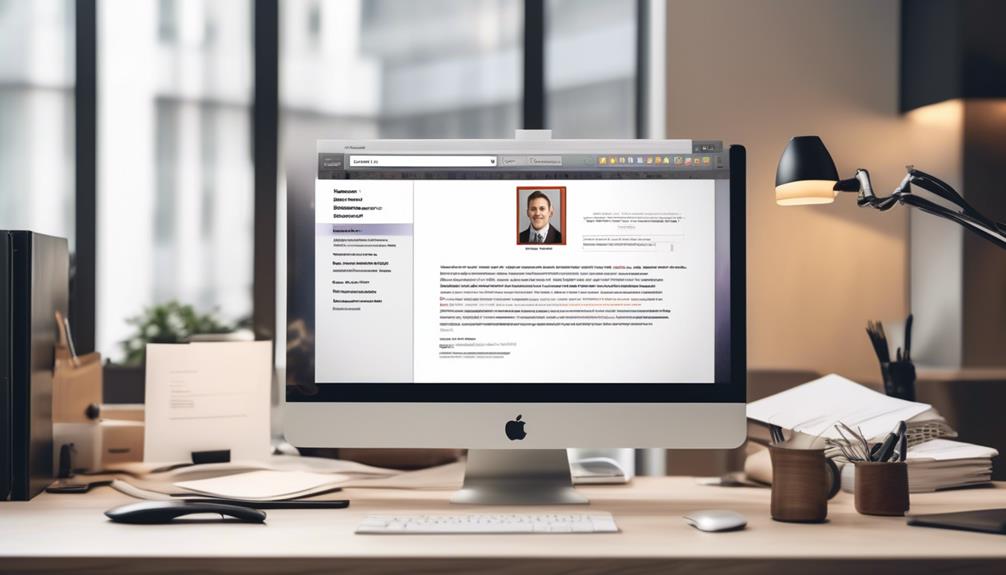Crafting an email to our boss is akin to balancing on a tightrope – we have to find that ideal equilibrium between being professional and accessible.
But how do we ensure that our message hits the mark without tipping the scales?
Well, let's just say there's a method to the madness, and it all starts with the first few lines of your email.
Curious to know how to grab your boss's attention and maintain their interest?
Keep on reading to uncover the key elements of composing a compelling email that leaves a lasting impression.
Key Takeaways
- Use clear and concise subject lines that accurately reflect the purpose of the email.
- Begin with a professional greeting and clearly state the reason for the email in the opening paragraph.
- Proofread for spelling and grammatical errors before sending, and maintain a professional tone and language throughout the email.
- When requesting time off or addressing issues, be specific, express gratitude, and request confirmation or follow-up steps.
Email Etiquette for Boss Communication
When communicating with your boss via email, using proper etiquette is essential for maintaining a professional and respectful tone.
It's important to start off with a clear and concise subject line that indicates the purpose of your email, such as 'Meeting Request for Feedback on Project X.' This helps your boss understand the context of your email at a glance.
Begin the email with a professional greeting, using appropriate titles and last names, such as 'Dear Mr. Smith.'
Clearly state the reason for your email in the opening paragraph, providing necessary details in a respectful and professional tone. For example, 'I hope to request a meeting with you to discuss the feedback on the latest project.'
End the email with a clear call to action or next steps, such as 'Please let me know your availability for the meeting,' and a professional sign-off, like 'Best regards.'
Lastly, always proofread the email for any spelling or grammatical errors before sending it to ensure clear and effective communication.
Effective Subject Lines for Boss Emails

When crafting subject lines for emails to our boss, it's crucial to be concise and clearly convey the purpose of the email. Using relevant keywords can make the subject line more searchable and attention-grabbing.
We should also ensure that the subject line accurately reflects the content of the email to maintain clarity and relevance.
Relevance of Subject Lines
Crafting effective subject lines for emails to your boss requires clarity and brevity, succinctly conveying the purpose of the message in fewer than 10 words. When addressing your boss via email, the subject line should be attention-grabbing and informative. To achieve this, we recommend the following strategies:
- Use action-oriented language to convey urgency or importance.
- Incorporate keywords related to the content, such as 'work schedule' or 'meeting request.'
- Personalize the subject line to resonate with your boss's interests or priorities.
- Avoid using complete sentences or unnecessary punctuation to maintain professionalism.
- Ensure the subject line provides a concise description of the email's purpose, fostering efficient communication with your boss.
Crafting subject lines that are relevant and purposeful will enhance the effectiveness of your professional emails to your boss.
Impact of Clear Communication
Transitioning from the discussion on crafting effective subject lines for emails to your boss, it is crucial to recognize the impact of clear communication in ensuring the effectiveness of professional correspondence. Clear communication not only conveys your message effectively but also reflects your professionalism. When writing an email to your boss, whether it's a request for time off, a performance review, or seeking assistance in providing valuable feedback, clear communication is essential. It helps to ensure a smooth transition and fosters a positive professional relationship. Below is an example of how clear communication can impact your email to your boss:
| Without Clear Communication | With Clear Communication |
|---|---|
| Unclear subject line | Concise, specific subject line |
| Rambling content | Well-structured, to-the-point content |
| Lack of clear ask | Direct, polite request for assistance |
| Ambiguous tone | Professional, respectful tone |
| Inadequate follow-up | Timely, effective follow-up |
Clear communication is the cornerstone of successful email correspondence with your boss.
Professional Tone and Language
Maintain a positive and confident tone while using concise and professional language in your email communication with your boss. It's important to convey professionalism and respect when reaching out to your boss through email.
Here are some tips to help you achieve the right tone and language in your correspondence:
- Use language that reflects your professionalism and expertise.
- Be mindful of the tone of your email, ensuring it's respectful and courteous.
- Avoid using overly casual language or jargon that may not be appropriate for professional communication.
- Clearly and concisely express your request, ensuring that your boss understands the purpose of your email.
- Proofread your email for any grammar or spelling errors to maintain a high level of professionalism.
When emailing your boss, the tone and language you use can greatly impact how your message is received. By following these guidelines, you can ensure that your emails maintain a professional and respectful tone while effectively conveying your message.
Requesting Time Off or Leave

Hey there!
When requesting time off or leave from your boss, it's important to be clear and considerate. Specify the reason for your request and the dates you're seeking time off, and offer to discuss any necessary arrangements.
It's also a good idea to express gratitude for considering your request and to request confirmation of the approval or any follow-up steps required.
Time off Request
When requesting time off from your boss, it's important to clearly and concisely state the reason for your request and specify the dates you're seeking to be absent from work.
In the email, I recommend incorporating the following bullet points to evoke emotion in the audience:
- Request a meeting to discuss the time off request and ensure a smooth transition of my responsibilities.
- If applicable, mention the need for medical leave and provide relevant details.
- Specify the dates and times for the requested time off, considering the company's culture and workload.
- Offer to coordinate coverage for your responsibilities during your absence.
- Express willingness to request additional information or work from home if feasible.
Leave of Absence
In the email, we will clearly state the reason for the requested leave of absence and specify the dates for the time off. It is important to be transparent and provide as much detail as possible. Below is a helpful table to guide the email structure:
| Information to Include | Example |
|---|---|
| Reason for Leave | Family Emergency |
| Dates of Absence | June 15th – June 25th |
| Coverage Plan | Jane will handle my responsibilities |
| Request Confirmation | Please let me know by June 5th |
| Express Gratitude | Thank you for your understanding |
When asking your boss for a leave of absence, it's crucial to be considerate and provide a clear plan for your responsibilities during your time off. I recommend sending this email as soon as possible to allow for proper arrangements.
Seeking Guidance and Clarification

Seeking guidance and clarification on the matter at hand, I'd like to bring to your attention the specific details and proposed steps for resolution. I hope this email finds you well.
Regarding the recent project, I'm writing to request a performance review to gain insight into areas where I can improve and to receive feedback on my current performance. I kindly request a brief meeting at your earliest convenience to discuss and address any concerns you may have.
Additionally, I'm seeking your guidance on the best approach to handle the upcoming client presentation. Your expertise in this matter would be invaluable, and I'm eager to learn from your experience.
Furthermore, I'd appreciate your advice on how to effectively manage the team dynamics during our upcoming project.
Lastly, I'd like to request your time for a quick discussion on the new company policies. Your insights will be crucial in helping me understand the changes and adapt accordingly.
Thank you for considering my requests, and I look forward to your guidance.
Addressing Issues and Reporting Problems

We have encountered a specific issue that requires your attention.
Recently, we've noticed a decline in the performance of our customer service team, resulting in an increase in customer complaints. The average response time has exceeded our set standards, and the quality of responses has been inconsistent.
We believe that addressing this issue promptly is crucial to maintaining customer satisfaction and loyalty. To tackle this problem, we'd like to request a meeting to discuss potential solutions and strategies for improvement. Additionally, we seek your guidance on how to address this matter effectively.
We have already begun gathering specific details and evidence to support our observations. We're also prepared to provide a detailed report during the meeting. Furthermore, we're open to any suggestions or recommendations you may have in order to resolve this issue.
As a rule of thumb, we understand the importance of maintaining a high standard of performance, and we're committed to taking the necessary steps to rectify the situation. Your positive response and support in addressing this matter would be greatly appreciated.
Additionally, we'd like to request a letter outlining the agreed-upon strategies and solutions after the meeting for clarity and accountability.
Thank you for your attention to this matter.
Expressing Gratitude and Appreciation

We would like to express our sincere gratitude for your ongoing support and guidance. Your assistance has been invaluable, and we appreciate the opportunities you have provided us.
Here are a few specific reasons why we're grateful:
- Your guidance has been instrumental in our personal and professional growth.
- Your willingness to discuss and consider our ideas has been incredibly motivating.
- The trust you have placed in us to take on challenging projects has been both empowering and rewarding.
- Your leadership and mentorship have created a positive and productive work environment.
- The feedback and constructive criticism you have given us have helped us improve and excel in our roles.
Expressing our appreciation in this email is important to us, and we hope to continue contributing to the team under your guidance.
Thank you for all that you do.
Can the Same Email Format be Used for Both Your Boss and Manager?
Yes, the same email format for writing email updates to your manager and boss can be used. It should be professional, concise, and contain relevant information. Make sure to use a respectful tone and address each recipient appropriately. Keep in mind the hierarchy and individual preferences when addressing each one.
Frequently Asked Questions
How Do You Start an Email to Your Boss?
When starting an email to your boss, we usually begin with a polite and professional greeting. It's important to use their title and last name to show respect. For example, 'Dear Mr. Smith,' or 'Hello Dr. Johnson,'.
This sets the tone for the rest of the email and demonstrates courtesy. It's a simple but crucial step in maintaining a positive and respectful working relationship with your boss.
How Do You Start off an Email Professionally?
We start off a professional email by engaging the recipient with an interesting statistic, setting the tone for a meaningful conversation. This approach captures attention and demonstrates our commitment to delivering valuable information.
It's essential to begin with a clear and concise subject line that reflects the email's purpose, setting the tone for a professional exchange. This ensures that the recipient understands the relevance of the email and its potential impact.
How Do I Write an Email to My Boss About Concerns?
We start by clearly stating our concerns in the email to our boss.
We should use formal language and structure, and suggest a meeting to discuss the issue.
It's important to request confirmation of receipt and determine when it's appropriate to email or call.
We end the email with a professional closing.
This approach ensures that our concerns are communicated respectfully and effectively to our boss.
How Do You Write an Informal Email to Your Boss?
When writing an informal email to your boss, we strike a balance between maintaining professionalism and a relaxed tone. We ensure clarity, brevity, and respect in our communication.
Using a friendly greeting and a conversational tone can help establish a more approachable connection. While maintaining proper etiquette, we convey our message in a warm and friendly manner, fostering a positive working relationship with our boss.
Conclusion
In the fast-paced world of workplace communication, navigating the email etiquette for boss communication can feel like walking a tightrope.
But with the right subject lines, professional tone, and clear language, you can effectively navigate time off requests, seek guidance, address issues, and express gratitude.
Remember, the art of writing an email to your boss is like a delicate dance – with the right steps, you can make a lasting impression.










